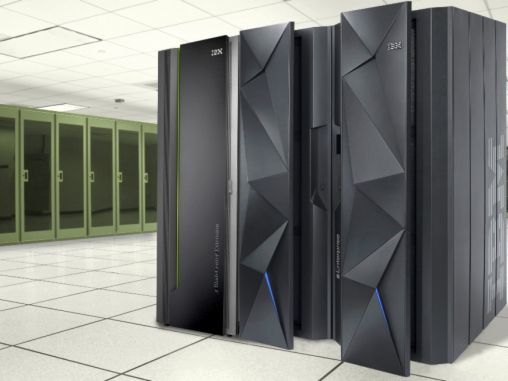IBM is targeting big enterprise customers to reconsider that whole distributed “private cloud” thing and considering ‘Hybrid Cloud’. IBM on August 2012 launched the zEnterprise EC12 mainframe, which serves as a blueprint for the evolution of Big Blue’s 48-year-old high-end system, with security, solid state storage enhancements, built-in analytics and the ability to be installed in a data center without a raised floor. IBM is hoping that companies will let the zEC12 assimilate their virtualization environments into a big, black cube.
With a new faster generation of CMOS processors and updated “hybrid” computing capabilities, the zEC12 is aimed at financial institutions, large enterprises, and government customers as a high-performance, high-security alternative to the “private cloud” model for performing large-scale analytics applications such as fraud detection. But IBM also has wider ambitions, positioning the zEC12 as a greener, faster alternative for nearly any set of enterprise applications. “When you have a product like System Z with its deep rich virtualization security, it’s possible to not only run traditional workloads but Linux and window workloads or aix workloads,” IBM General Manager for System Z Doug Balog told Ars in an interview. “It’s a fairly broad platform that can grow and handle all the sorts of workloads a client might want to run in a private cloud.”
According to IBM, the new mainframe can deliver 25 percent more performance and 50 percent more capacity with the same energy footprint as its predecessor. The price of the new mainframe is consistent with its predecessor z196, which starts at $1 million or so.
The zEC12 mainframe server packs 101 CMOS processor cores, up from 80 in the Z196, the most recent IBM mainframe predecessor introduced two years ago. And its cores run at a clock-rate of 5.5GHz, a 25 percent boost in processing speed. Overall, said Balog, “that comes together to make about 50 percent total computing capacity growth.” That capacity, IBM claims, can handle thousands of Linux virtual servers, and makes it cheaper to deploy a load of Linux-based Oracle servers on the zEC12 than on x86-based architectures.
Among the key features:
- A cryptographic co-processor and firmware via IBM Research designed to beef up security and meet the European Union’s digital signing standards. The co-processor is called Crypto Express4S, which supports numerous standards around the world.
- Automated information technology analytics embedded to learn from internal system messages. The analytics technology, called zAware, recognizes internal message patterns and spots unusual behavior. In many respects, zAware is a first step to self-healing systems. Jeff Frey, CTO of System z mainframes at IBM, said:
We’ve embedded technology to make it (zEnterprise EC12) a high performance resiliency analytics device. The system swallows up data from operational images and chews on it to provide insight on whether the system is behaving normally. We’re taking analytics and applying it inward. We haven’t yet introduced the ability for the system to make policy driven automatic recovery processes based on what it’s learning. But this is the first step.
- Solid state technology to handle bursts of activity at peak times.
- The ability to be installed without a raised data center floor. That feature is critical in emerging markets and allows the zEnterprise EC12 to offer more flexible layouts in a data center. Cabling and power supplies can be installed overhead.
- Transaction memory technology. IBM said it adapted the transaction memory model from its IBM Blue Gene/Q-based “Sequoia” system at Lawrence Livermore National Lab. The general idea is that EC12 can use that supercomputer technology to run applications concurrently and crunch multiple data sets. According to Frey, transaction memory technology allows a machine to create more throughput by committing memory, keeping track of all threads on a core and minimizing software interference.
IBM said it has spent more than $1 billion in research and development to enhance the mainframe, which is a staple at many large enterprises.
IBM also introduced a new generation of its zEnterprise BladeCenter Extension (zBX) for the zEC12, which provides for the integration of “specialty processor” blade servers into the mainframe’s infrastructure. The zBX Model 003 allows for “appliance” blades running AIX on IBM Power7 processors to integrate into the System Z environment, saving what IBM claims could be up to 55 percent of cost of ownership in comparison to a distributed data center model.
It’s hard to pin down hard numbers on those savings, however—some of them are based on projections from tests of the Z196, and IBM didn’t discuss pricing for the zEC12 in its announcement. IBM did mention a number of financing and leasing options for “credit-qualified clients.”
Specifically, IBM is aiming the mainframe at the “hybrid cloud,” which combines both internal systems and private and public clouds. The zEnterprise EC12 connects into IBM’s Power7 and System x servers to distribute computing power as one virtualized system..

Reblogged this on Security Obscurity and commented:
Great article.
Thank You.
I just started my blog a while ago and try to make it as a habit. Good job on your blog mate!